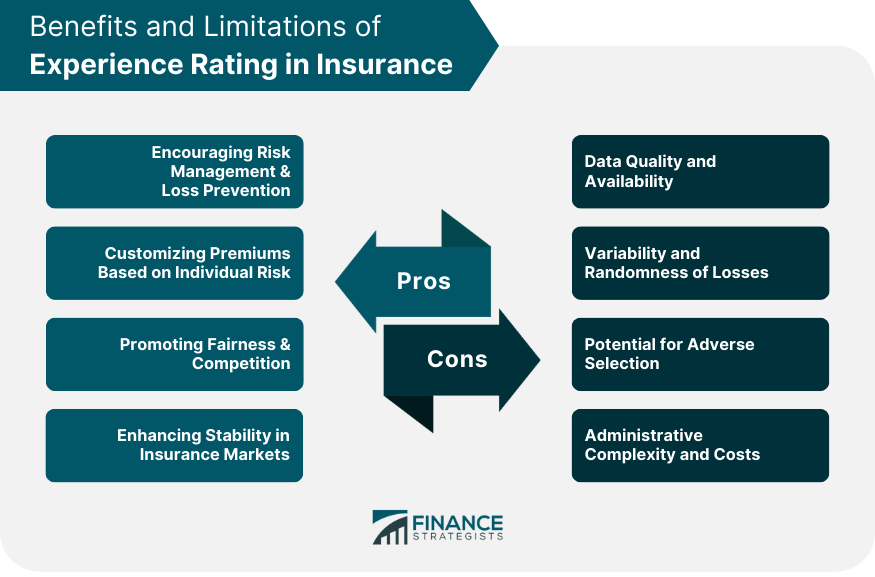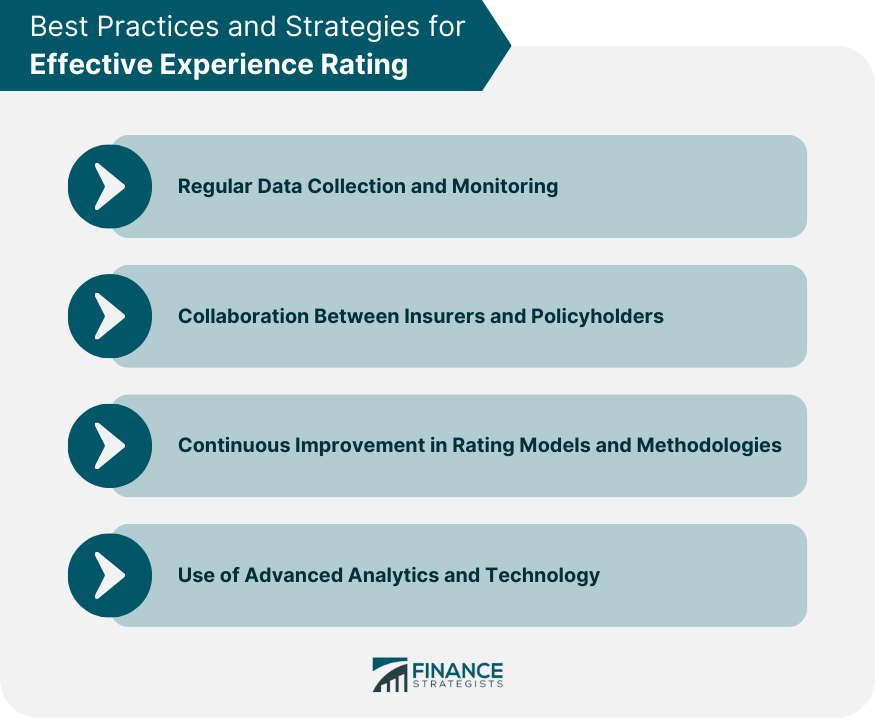Experience rating is a method used by insurance companies to determine premiums based on the historical loss experience of individual policyholders. This approach rewards those with lower loss histories with reduced premiums, while those with higher loss histories pay higher premiums. Experience rating is often contrasted with other rating methods, such as community rating, which sets premiums based on the average loss experience of a group of policyholders. The experience rating process involves several steps, including data collection and analysis, loss development and trending, credibility factors, and the calculation of an experience modification factor. Each of these steps is essential in determining the appropriate premium for a policyholder based on their unique loss experience. The first step in the experience rating process is collecting and analyzing relevant data. This includes: Insurance companies collect information on past claims made by policyholders, including the number, frequency, and severity of losses. This data is used to calculate the policyholder's loss ratio, which is the ratio of losses to premiums. Exposure data refers to the policyholder's level of risk exposure, which can vary depending on factors such as the size of the business, the number of employees, and the nature of the operations. This data helps insurers determine the expected losses for a given policyholder. Insurers also collect information on policyholder characteristics, such as the age of the business, its management practices, and its safety record. These factors can influence the likelihood of future losses and are considered when calculating experience-rated premiums. Loss development involves adjusting historical loss data to account for changes in exposure, inflation, and claim settlement patterns. Trending is the process of analyzing historical data to identify patterns and project future losses. Both loss development and trending are crucial in determining an accurate and reliable experience modification factor. Credibility factors are used to weight the importance of a policyholder's historical loss experience relative to the industry average. The more credible the policyholder's loss experience, the greater the impact on their experience-rated premium. Credibility factors are typically based on factors such as the size of the policyholder and the length of their loss history. The experience modification factor (EMF) is a numerical value that represents the policyholder's loss experience relative to the industry average. An EMF greater than 1.0 indicates a worse-than-average loss experience, resulting in higher premiums, while an EMF less than 1.0 indicates a better-than-average loss experience, leading to lower premiums. The EMF is calculated based on the policyholder's loss data, exposure data, and credibility factors. Experience rating is used across various insurance lines, including workers' compensation, auto, general liability, and property insurance. In each of these lines, the experience rating process is tailored to the unique risks and exposures associated with the specific type of coverage. In workers' compensation insurance, experience rating is used to set premiums based on the policyholder's past claims experience and payroll data. The National Council on Compensation Insurance (NCCI) and other state rating bureaus typically provide the experience rating formulas and factors used by insurers. Experience rating in commercial auto insurance considers factors such as the policyholder's claims history, fleet size, and vehicle types. Insurers may use proprietary rating models or industry-standard models, such as the Insurance Services Office (ISO) Commercial Automobile Experience Rating Plan. For general liability insurance, experience rating takes into account factors such as the policyholder's claims history, business operations, and exposure to liability risks. The experience rating process may involve the use of industry classification codes and loss cost multipliers to determine the appropriate premium for a policyholder based on their unique risk profile. In property insurance, experience rating considers factors such as the policyholder's claims history, the type and location of the property, and any risk mitigation measures in place. Insurers may use rating models that incorporate catastrophe modeling and geographic risk factors to set experience-rated premiums. Experience rating offers several benefits to both insurers and policyholders, including: By linking premiums to historical loss experience, experience rating encourages policyholders to invest in risk management and loss prevention measures. Businesses with lower loss histories are rewarded with lower premiums, creating a financial incentive to maintain safe operations. Experience rating allows insurers to set premiums that more accurately reflect the individual risk profile of each policyholder. This results in a fairer pricing structure that takes into account the unique characteristics and loss experience of each insured. By differentiating premiums based on historical loss experience, experience rating promotes fairness and competition among policyholders. Businesses with better loss histories are rewarded with lower premiums, while those with worse loss histories face higher premiums, incentivizing them to improve their risk management practices. Experience rating can contribute to greater stability in insurance markets by ensuring that premiums are more closely aligned with the underlying risk. This helps maintain the financial solvency of insurers and ensures that policyholders are adequately covered in the event of a loss. Despite its benefits, experience rating also has some limitations and challenges, including: Experience rating relies on the availability and quality of historical loss and exposure data. Incomplete or inaccurate data can lead to mispricing of premiums and undermine the effectiveness of the experience rating process. The experience rating process is subject to the inherent variability and randomness of losses. As a result, a policyholder's historical loss experience may not always be an accurate predictor of future losses, potentially leading to mispricing of premiums. Experience rating may create the potential for adverse selection, as policyholders with poor loss histories may be more likely to seek coverage from insurers with less stringent experience rating practices. This can result in a concentration of high-risk policyholders among certain insurers, potentially threatening their financial solvency. The experience rating process can be administratively complex and costly for insurers, particularly in cases where data must be collected and analyzed across multiple jurisdictions or lines of insurance. To maximize the effectiveness of experience rating, insurers and policyholders can adopt several best practices and strategies, including: Insurers should prioritize regular data collection and monitoring to ensure the accuracy and reliability of the experience rating process. This includes maintaining up-to-date loss and exposure data and regularly reviewing and updating rating models and methodologies. Effective experience rating requires close collaboration between insurers and policyholders. Insurers should provide policyholders with clear information on their experience rating factors and premiums, while policyholders should be proactive in sharing information on their risk management practices and loss history. Insurers should continually invest in improving their rating models and methodologies to ensure the accuracy and fairness of experience rating. This may involve incorporating new data sources, advanced analytics, and emerging risk factors into the rating process. Advanced analytics and technology can help insurers enhance the experience rating process by providing more accurate and timely insights into policyholder risk profiles. Machine learning algorithms, predictive analytics, and data visualization tools can all contribute to more effective experience rating. Experience rating plays a vital role in insurance risk management by enabling insurers to set premiums that reflect the unique loss history of each policyholder. This approach not only promotes fairness and competition in the insurance market but also incentivizes businesses to invest in risk management and loss prevention measures. As the industry continues to evolve, experience rating is likely to be impacted by trends such as big data, advanced analytics, and alternative data sources, leading to more sophisticated rating models and methodologies. To ensure that experience rating remains an effective tool for managing risk and setting fair premiums, insurers and policyholders must stay abreast of these developments and adopt best practices. By prioritizing regular data collection and monitoring, fostering collaboration, and continually investing in improvements, the insurance industry can ensure that experience rating continues to accurately assess risk and promote responsible risk management practices.Experience Rating in Insurance: Overview
The Experience Rating Process
Data Collection and Analysis
Loss Data
Exposure Data
Policyholder Characteristics
Loss Development and Trending
Credibility Factors
Calculation of Experience Modification Factor
Experience Rating in Various Insurance Lines
Workers' Compensation Insurance
Commercial Auto Insurance
General Liability Insurance
Property Insurance
Benefits of Experience Rating in Insurance
Encouraging Risk Management and Loss Prevention
Customizing Premiums Based on Individual Risk
Promoting Fairness and Competition
Enhancing Stability in Insurance Markets
Limitations and Challenges of Experience Rating in Insurance
Data Quality and Availability
Variability and Randomness of Losses
Potential for Adverse Selection
Administrative Complexity and Costs

Best Practices and Strategies for Effective Experience Rating
Regular Data Collection and Monitoring
Collaboration Between Insurers and Policyholders
Continuous Improvement in Rating Models and Methodologies
Use of Advanced Analytics and Technology

Conclusion
Experience Rating in Insurance FAQs
Experience rating is a system used by insurers to determine the premium rate for a policy based on the policyholder's claims history. It involves analyzing the policyholder's past claims and adjusting the premium based on the likelihood of future claims.
Experience rating is based on the idea that past behavior can predict future outcomes. Insurance companies collect data on past claims made by a policyholder, including the frequency and severity of the claims. This data is used to calculate a modification factor that is applied to the policyholder's premium rate. A policyholder with a good claims history will receive a lower premium rate, while a policyholder with a poor claims history will receive a higher premium rate.
Experience rating is commonly used by commercial insurance companies to determine the premium rate for policies such as workers' compensation and general liability insurance. It is also used in other industries, such as healthcare, to determine the cost of insurance coverage.
Experience rating allows insurance companies to provide customized premium rates based on the individual policyholder's risk profile. This can result in lower premiums for policyholders with a good claims history, and can encourage policyholders to maintain a safe working environment and take steps to minimize risk.
One of the drawbacks of experience rating is that it can create a disincentive for policyholders to report claims. If a policyholder knows that their claims history will result in a higher premium rate, they may be hesitant to report claims, which can result in increased costs in the long run. Additionally, experience rating may not accurately reflect changes in a policyholder's risk profile, such as improvements in safety protocols or changes in the nature of the business.
True Tamplin is a published author, public speaker, CEO of UpDigital, and founder of Finance Strategists.
True is a Certified Educator in Personal Finance (CEPF®), author of The Handy Financial Ratios Guide, a member of the Society for Advancing Business Editing and Writing, contributes to his financial education site, Finance Strategists, and has spoken to various financial communities such as the CFA Institute, as well as university students like his Alma mater, Biola University, where he received a bachelor of science in business and data analytics.
To learn more about True, visit his personal website or view his author profiles on Amazon, Nasdaq and Forbes.











